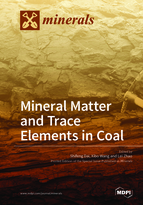Minerals in Coal
A special issue of Minerals (ISSN 2075-163X).
Deadline for manuscript submissions: closed (31 January 2016) | Viewed by 143731
Special Issue Editors
Interests: coal mineralogy; coal geochemistry; coal petrology; coal combustion products
Special Issues, Collections and Topics in MDPI journals
Interests: coal geochemistry; coal mineralogy; coal petrology, coal geochemistry, and coal-bearing strata sedimentology
Special Issues, Collections and Topics in MDPI journals
Interests: mineral matter and trace elements in coal; strategically critical metals in coal-bearing sequences and coal combustion by-products; environmental impact of coal combustion by-products
Special Issues, Collections and Topics in MDPI journals
Special Issue Information
Dear Colleagues,
Minerals are very significant components of coal from both academic and practical perspectives. Minerals may react when the coal is burned, either forming an ash residue, or, in many cases, releasing volatile components, or being needed to be removed as slag from the blast furnace during metallurgical processing. Minerals in coal can also be a source of unwanted abrasion, stickiness, corrosion, or pollution associated with coal handling and use. Minerals in coal, in some cases, are major carriers of valuable metals, such as Ga, Al, and rare earth elements, and these coals with highly-evaluated valuable metals have the potential to be raw sources for industry use. From the genetic point of view, the minerals in coal are products of the processes associated with peat accumulation and rank advance, as well as other aspects of epigenetic processes, and, thus, the minerals in coal can provide information on the depositional conditions and geologic history of individual coal beds, coal-bearing sequences, and regional tectonic evolution. This Special Issue, “Minerals in Coal”, focuses on providing an up-to-date series of papers, covering research and technological developments in the nature, origin, and significance of the minerals in coal, and productions derived from combustion and gasification.
Prof. Dr. Shifeng Dai
Dr. Xibo Wang
Dr. Lei Zhao
Guest Editor
Manuscript Submission Information
Manuscripts should be submitted online at www.mdpi.com by registering and logging in to this website. Once you are registered, click here to go to the submission form. Manuscripts can be submitted until the deadline. All submissions that pass pre-check are peer-reviewed. Accepted papers will be published continuously in the journal (as soon as accepted) and will be listed together on the special issue website. Research articles, review articles as well as short communications are invited. For planned papers, a title and short abstract (about 100 words) can be sent to the Editorial Office for announcement on this website.
Submitted manuscripts should not have been published previously, nor be under consideration for publication elsewhere (except conference proceedings papers). All manuscripts are thoroughly refereed through a single-blind peer-review process. A guide for authors and other relevant information for submission of manuscripts is available on the Instructions for Authors page. Minerals is an international peer-reviewed open access monthly journal published by MDPI.
Please visit the Instructions for Authors page before submitting a manuscript. The Article Processing Charge (APC) for publication in this open access journal is 2400 CHF (Swiss Francs). Submitted papers should be well formatted and use good English. Authors may use MDPI's English editing service prior to publication or during author revisions.







